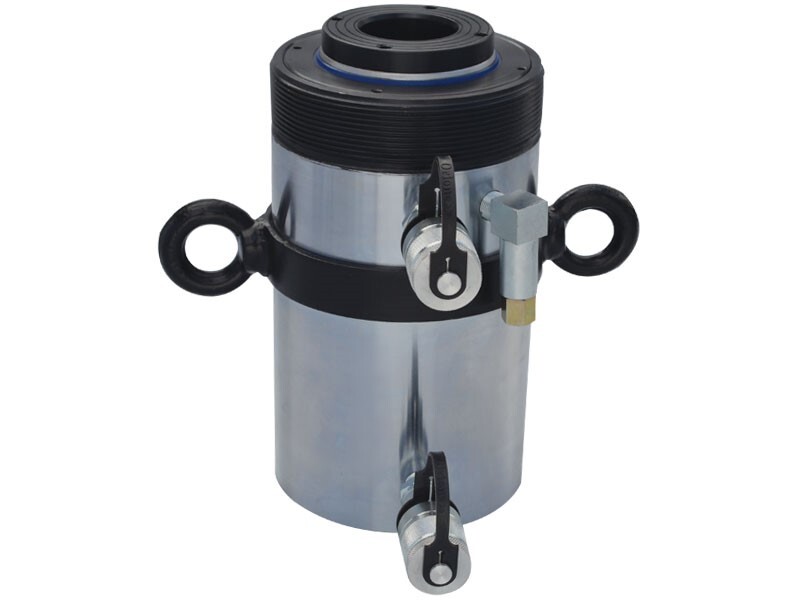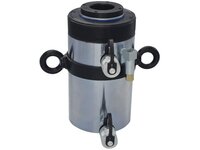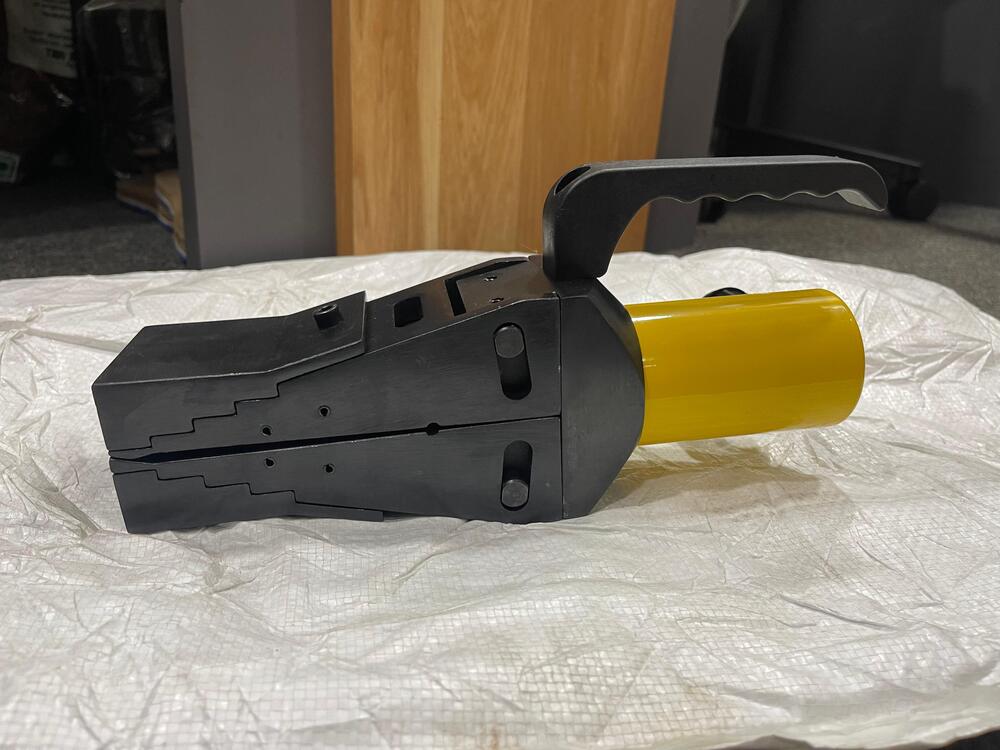





Hydraulic Hollow Ram Jacks Plain Ram Double Acting Oil Return
Product Details:
Hydraulic Hollow Ram Jacks Plain Ram Double Acting Oil Return Price And Quantity
- 40000.00 - 45000.00 INR/Piece
- 1 Piece
- 45000 INR/Piece
Product Description
Capacity 10 - 150 ton / Stroke 50 - 150 mm / Max. Working Pressure 700 bar
| Capacity (ton) |
Capacity (kN) |
Stroke (mm) |
Model | Effective area (cm2) |
Oil cap. (cc) |
Closed height (mm) |
Wt. (Approx.) (kg) |
|---|---|---|---|---|---|---|---|
| 10 | 103 | 75 | ODH 10-75 | 14.7 | 110 | 195 | 5.5 |
| 10 | 103 | 100 | ODH 10-100 | 14.7 | 147 | 220 | 6 |
| 20 | 202 | 50 | ODH 20-50 | 28.9 | 144 | 185 | 12 |
| 20 | 202 | 100 | ODH 20-100 | 28.9 | 289 | 235 | 14.5 |
| 20 | 202 | 150 | ODH 20-150 | 28.9 | 433 | 285 | 17 |
| 30 | 309 | 50 | ODH 30-50 | 44.2 | 221 | 200 | 13.5 |
| 30 | 309 | 100 | ODH 30-100 | 44.2 | 442 | 250 | 16 |
| 30 | 309 | 150 | ODH 30-150 | 44.2 | 663 | 300 | 19 |
| 50 | 528 | 100 | ODH 50-100 | 75.4 | 754 | 260 | 28 |
| 60 | 641 | 75 | ODH 30-75 | 91.6 | 687 | 245 | 27.5 |
| 60 | 641 | 100 | ODH 30-100 | 91.6 | 916 | 270 | 30 |
| 60 | 641 | 150 | ODH 30-150 | 91.6 | 1373 | 320 | 34.5 |
| 100 | 1093 | 75 | ODH 100-75 | 156.1 | 1171 | 270 | 53 |
| 100 | 1093 | 100 | ODH 100-100 | 156.1 | 1561 | 295 | 57 |
| 150 | 1649 | 150 | ODH 150-150 | 235.6 | 3534 | 350 | 95 |
Features of Hollow Ram Jacks Double Acting
Hollow ram jacks double acting are hydraulic cylinders with a hollow plunger allowing pull and push forces. They are used for various applications such as construction, lifting, tensioning, and testing. Here are some of the features of hollow ram jacks double acting:
- They have a high capacity ranging from 10 to 150 tons.
- They have a long stroke ranging from 50 to 250 mm.
- They have a maximum working pressure of 700 bar.
- They have a fast and precise retraction due to the hydraulic force on both sides of the plunger.
- They have an aluminum or steel body that is durable and corrosion-resistant.
- They have a hollow plunger that allows for passing cables, rods, or wires through it.
- They have a spring-loaded safety valve that prevents overpressurization.
- They have a collar thread and base mounting holes for easy installation and attachment.
Applications of Hollow Ram Jacks Double Acting
Hollow ram jacks are hydraulic cylinders with a hole through the center of the piston and plunger. They are used for applications that require pulling, pushing, tensioning, or clamping forces. Hollow ram jacks can be single-acting or double-acting. Single-acting hollow ram jacks use hydraulic pressure to extend the plunger and rely on a spring or gravity to retract it. Double-acting hollow ram jacks use hydraulic pressure to extend and retract the plunger, allowing for faster and more precise control.
Double-acting hollow ram jacks have several advantages over single-acting ones. They can provide continuous force in both directions, which is helpful for applications that require push and pull forces. They can also retract faster than single-acting ones, which reduces cycle time and increases productivity. Moreover, they can prevent plunger drift caused by external loads or leaks, which improves accuracy and safety.
Some of the standard applications of double-acting hollow ram jacks are:
Pile Load Testing
Pile load testing is a method of assessing the bearing capacity and settlement behavior of piles under axial loads. Piles are structural elements that transfer loads from buildings or bridges to deeper soil layers or bedrock. Pile load testing involves applying a controlled load to the pile head and measuring its displacement.
Double-acting hollow ram jacks are often used for pile load testing because they can apply both compression and tension loads to the pile head. The hole in the center of the jack allows a threaded rod or cable to pass through it and connect to the pile head. The jack can then apply a downward or upward force on the rod or line, depending on whether compression or tension testing is required.
Post-Tensioning
Post-tensioning is a technique of reinforcing concrete structures by applying prestressing forces to embedded steel tendons. Prestressing forces are applied after the concrete has hardened, hence the name post-tensioning. Post-tensioning improves concrete structures' strength, durability, and performance by reducing cracking, deflection, and shrinkage.
Double-acting hollow ram jacks are often used for post-tensioning because they can apply tensioning and detensioning forces to the tendons. The hole in the center of the jack allows a tendon to pass through it and connect to an anchor at each end. The jack can then apply a pulling or pushing force on the tendon, depending on whether tensioning or detensioning is required.
Cable Splicing
Cable splicing is a process of joining two cables together by welding, soldering, crimping, or other methods. Cable splicing is often done to repair damaged lines, extend existing threads,or connect different types of cables.
Double-acting hollow ram jacks are often used for cable splicing because they can apply clampings and release forces to the cable ends. The hole in the center of the jack allows a cable to pass through it and connect to a splice device at each end.
The jack can then apply a squeezing or releasing force on the cable ends, depending on whether clamping or removing is required.
How to Use Hollow Ram Jacks Double Acting?
To use hollow ram jacks double acting safely and effectively, you should follow these steps:
1. Select the appropriate jack size and capacity for your application. The jack should have enough stroke length to complete the task without exceeding its maximum pressure rating.
2. Connect the jack to a suitable hydraulic pump with high-pressure hoses and fittings. Make sure there are no leaks or damages in the system.
3. Place the jack on a flat, stable surface that can support its weight and load. Align the center hole of the plunger with the load or accessory. Do not use spacers or extensions that may cause instability or misalignment.
4. Open the release valve on the pump and extend the plunger by pumping oil into it. Ensure there is enough clearance for the plunger to retract fully when needed.
5. Close the release valve on the pump and retract the plunger by reversing the oil flow direction with a four-way valve. Monitor the pressure gauge on the pump and do not exceed its maximum limit.
6. Repeat steps 4 and 5 as needed until you complete your task. Do not overload or overextend the jack, as it may cause damage or injury.
7. When finished, open the release valve on the pump and remove any load or accessory from the plunger. Disconnect the hoses and fittings from the jack and store them properly.
Hollow ram jacks double acting are versatile tools that help you with various tasks involving push-pull forces. However, they also require proper selection, installation, operation, and maintenance to ensure safety and efficiency.

Price:
- 50
- 100
- 200
- 250
- 500
- 1000+

 Send Inquiry
Send Inquiry









